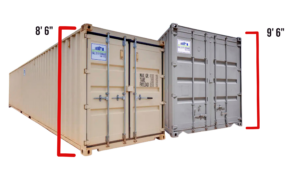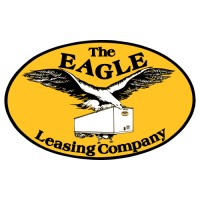Standard vs High-Cube Container – Key Differences at a Glance
When you’re renting a shipping container, size matters—but it’s not just about length. Height plays a huge role in how you use the space inside, and that’s where the standard vs high-cube container decision comes in.
You might’ve seen “high-cube” listed next to 20’ or 40’ containers and wondered what the real difference is. Simply put: standard containers are 8’6” tall, while high-cubes are 9’6”—giving you an extra foot of vertical space for storage, mobility, and custom setups.
We’ve got you covered—here’s a clear breakdown to help you choose the right fit for your project.
What’s the Actual Size Difference?
Let’s start with the numbers:
- Standard Container Height: ~8’6” tall (exterior)
- High-Cube Container Height: ~9’6” tall (exterior)
So, you’re getting about one extra foot of vertical space with a high-cube. Doesn’t sound like much? It can make a big difference.
Why the Extra Height in a High-Cube Container Matters
That extra foot can mean the difference between:
-
Stacking two pallets vs. three
-
Standing up tall shelving vs. laying it down
-
Comfortably walking inside your mobile workspace vs. ducking your head
If you plan to maximize vertical space, store oversized equipment, or even convert a container into an office or workspace, the high-cube option is often the smarter choice.
When to Choose a Standard Container
Go with a standard 8’6” unit if:
-
You’re storing small to medium items like tools, boxes, seasonal inventory
-
The container will be used short-term and doesn’t require interior walk-through space
-
You’re dealing with low clearance areas (under power lines, trees, tight alleyways)
-
Budget is tight and you don’t need the extra foot
Pro Tip: Standard containers are slightly more affordable to rent and deliver—especially in tight urban areas.
When to Choose a High-Cube Container
High-cube containers are ideal for:
-
Tall equipment (like racking systems, industrial gear, or oversized furniture)
-
Jobsites where you’ll frequently walk in/out of the unit
-
Conversions into mobile offices, pop-ups, or workshops
-
Customers who want more cubic footage without upgrading to a longer container
They’re especially helpful when floor space is limited but you still need storage volume.
A Real Example from Our Customers:
We had a customer in Philadelphia converting a 20’ container into a mobile bike repair station. The standard height made it hard for techs to stand comfortably inside. Swapping to a 20’ high-cube gave them extra headroom and space to install wall-mounted tools—problem solved.
What About Availability?
Both standard and high-cube containers are available in 20’ and 40’ sizes, but high-cubes are slightly less common and may require extra scheduling notice in certain regions.
Not sure what’s available near you? Contact us and we’ll walk you through local stock and options.
Final Thoughts
The difference between a standard and high-cube container might seem small, but it can make a big impact—on space, comfort, efficiency, and budget.
If you’re still unsure, start by figuring out what’s going inside, how often you’ll access it, and where it’s going to sit.
👉 Need help choosing a size overall—not just the height?
Check out our partner Eagle Leasing’s excellent breakdown:
Container Rental Guide: What Size Is Right?

Or just give us a call. We’ll give you the honest answer—no up-sell, no pressure.
